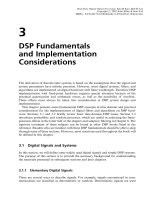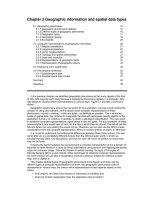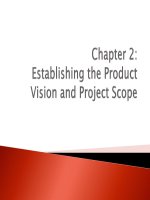Lecture BSc Multimedia - Chapter 2: DSP, filters and the fourier transform
Bạn đang xem bản rút gọn của tài liệu. Xem và tải ngay bản đầy đủ của tài liệu tại đây (3.08 MB, 107 trang )
CM3106 Chapter 2:
DSP, Filters and the Fourier Transform
Prof David Marshall
and
Dr Kirill Sidorov
www.facebook.com/kirill.sidorov
School of Computer Science & Informatics
Cardiff University, UK
Digital Signal Processing and Digital Audio
Recap from CM2202
Issues to be Recapped:
Basic Digital Signal Processing and Digital Audio
Waveforms and Sampling Theorem
Digital Audio Signal Processing
Filters
For full details please refer to last Year’s
CM2202 Course Material — Especially detailed
underpinning maths.
CM3106 Chapter 2
Digital Signal Processing and Digital Audio Recap from CM2202
2
Simple Waveforms
Frequency is the number of cycles per second and is
measured in Hertz (Hz)
Wavelength is inversely proportional to frequency
1
i.e. Wavelength varies as frequency
CM3106 Chapter 2
Basic Digital Audio Signal Processing
3
The Sine Wave and Sound
The general form of the sine wave we shall use (quite a lot of)
is as follows:
y = A.sin(2π.n.Fw /Fs )
where:
A is the amplitude of the wave,
Fw is the frequency of the wave,
Fs is the sample frequency,
n is the sample index.
MATLAB function: sin() used — works in radians
CM3106 Chapter 2
Basic Digital Audio Signal Processing
4
Relationship Between Amplitude, Frequency and
Phase
CM3106 Chapter 2
Recap: Relationship Between Amplitude, Frequency and Phase
5
Phase of a Sine Wave
sinphasedemo.m
% Simple Sin Phase Demo
samp_freq = 400;
dur = 800; % 2 seconds
amp = 1; phase = 0; freq = 1;
s1 = mysin(amp,freq,phase,dur,samp_freq);
axisx = (1:dur)*360/samp_freq; % x axis in degrees
plot(axisx,s1);
set(gca,’XTick’,[0:90:axisx(end)]);
fprintf(’Initial Wave: \t Amplitude = ...\n’, amp, freq, phase,...);
% change amplitude
phase = input(’\nEnter Phase:\n\n’);
s2 = mysin(amp,freq,phase,dur,samp_freq);
hold on;
plot(axisx, s2,’r’);
set(gca,’XTick’,[0:90:axisx(end)]);
CM3106 Chapter 2
Recap: Relationship Between Amplitude, Frequency and Phase
6
Phase of a Sine Wave: sinphasedemo output
1
0.8
0.6
0.4
0.2
0
−0.2
−0.4
−0.6
−0.8
−1
0
90
180
CM3106 Chapter 2
270
360
450
540
630
Recap: Relationship Between Amplitude, Frequency and Phase
7
Basic DSP Concepts and Definitions: The Decibel
(dB)
When referring to measurements of power or intensity, we express these
in decibels (dB):
XdB = 10 log10
where:
X
X0
X is the actual value of the quantity being measured,
X0 is a specified or implied reference level,
XdB is the quantity expressed in units of decibels, relative to X0 .
X and X0 must have the same dimensions — they must measure
the same type of quantity in the the same units.
The reference level itself is always at 0 dB — as shown by setting
X = X0 (note: log10 (1) = 0).
CM3106 Chapter 2
Basic DSP Concepts and Definitions
8
Why Use Decibel Scales?
When there is a large range in frequency or magnitude,
logarithm units often used.
If X is greater than X0 then XdB is positive (Power
Increase)
If X is less than X0 then XdB is negative (Power
decrease).
Power Magnitude = |X (i)|2 | so (with respect to reference
level)
XdB = 10 log10 (|X (i)2 |)
= 20 log10 (|X (i)|)
which is an expression of dB we often come across.
CM3106 Chapter 2
Basic DSP Concepts and Definitions
9
Decibel and Chillies!
Decibels are used to express wide dynamic ranges in a many applications:
CM3106 Chapter 2
Basic DSP Concepts and Definitions
10
Decibel and acoustics
dB is commonly used to quantify sound levels relative to
some 0 dB reference.
The reference level is typically set at the
threshold of human perception
Human ear is capable of detecting a very large range of
sound pressures.
CM3106 Chapter 2
Basic DSP Concepts and Definitions
11
Examples of dB measurement in Sound
Threshold of Pain
The ratio of sound pressure that causes permanent damage
from short exposure to the limit that (undamaged) ears can
hear is above a million:
The ratio of the maximum power to the minimum power
is above one (short scale) trillion (1012 ).
The log of a trillion is 12, so this ratio represents a
difference of 120 dB.
120 dB is the quoted Threshold of Pain for Humans.
CM3106 Chapter 2
Basic DSP Concepts and Definitions
12
Examples of dB measurement in Sound (cont.)
Speech Sensitivity
Human ear is not equally sensitive to all the frequencies of sound
within the entire spectrum:
Maximum human sensitivity at noise levels at between 2 and
4 kHz (Speech)
These are factored more heavily into sound descriptions
using a process called frequency weighting.
Filter (Partition) into frequency bands concentrated in
this range.
Used for Speech Analysis
Mathematical Modelling of Human Hearing
Audio Compression (E.g. MPEG Audio)
CM3106 Chapter 2
Basic DSP Concepts and Definitions
13
Examples of dB measurement in Sound (cont.)
Digital Noise increases by 6dB per bit
In digital audio sample representation (linear pulse-code modulation (PCM)),
The first bit (least significant bit, or LSB) produces residual quantization noise
(bearing little resemblance to the source signal)
Each subsequent bit offered by the system doubles the
resolution, corresponding to a 6 (= 10 ∗ log10 (4)) dB.
So a 16-bit (linear) audio format offers 15 bits beyond the first, for a dynamic
range (between quantization noise and clipping) of (15 x 6) = 90 dB, meaning
that the maximum signal is 90 dB above the theoretical peak(s) of quantisation
noise.
8-bit linear PCM similarly gives (7 x 6) = 42 dB.
48 dB difference between 8- and 16-bit which is (48/6 (dB))
8 times as noisy.
CM3106 Chapter 2
Basic DSP Concepts and Definitions
14
Signal to Noise
Signal-to-noise ratio is a term for the power ratio between a
signal (meaningful information) and the background noise:
Psignal
SNR =
=
Pnoise
Asignal
Anoise
2
where P is average power and A is RMS amplitude.
Both signal and noise power (or amplitude) must be
measured at the same or equivalent points in a system,
and within the same system bandwidth.
Because many signals have a very wide dynamic range, SNRs
are usually expressed in terms of the logarithmic decibel scale:
SNRdB = 10 log10
CM3106 Chapter 2
Psignal
Pnoise
= 20 log10
Basic DSP Concepts and Definitions
Asignal
Anoise
15
System Representation: Algorithms and Signal
Flow Graphs
It is common to represent digital system signal processing
routines as a visual signal flow graphs.
We use a simple equation relation to describe the algorithm.
Three Basic Building Blocks
We will need to consider three processes:
Delay
Multiplication
Summation
CM3106 Chapter 2
System Representation: Algorithms and Signal Flow Graphs
16
Signal Flow Graphs: Delay
Delay
We represent a delay of one sampling interval by a
block with a T label:
x(n)
T
y(n) = x(n − 1)
We describe the algorithm via the equation:
y (n) = x(n − 1)
CM3106 Chapter 2
System Representation: Algorithms and Signal Flow Graphs
17
Signal Flow Graphs: Delay Example
A Delay of 2 Samples
A delay of the input signal by two sampling intervals:
We can describe the algorithm by:
y(n) = x(n − 2)
We can use the block diagram to represent the signal flow graph
as:
x(n)
x(n)
CM3106 Chapter 2
T
y(n) = x(n − 1)
T
y(n) = x(n − 2)
y (n) = x(n − 2)
System Representation: Algorithms and Signal Flow Graphs
18
Signal Flow Graphs: Multiplication
Multiplication
We represent a multiplication or weighting of the input
signal by a circle with a × label .
We describe the algorithm via the equation: y(n) = a.x(n)
a
x(n)
×
y(n) = a.x(n)
e.g. a = 0.5
x(n)
CM3106 Chapter 2
y (n) = 0.5x(n)
System Representation: Algorithms and Signal Flow Graphs
19
Signal Flow Graphs: Addition
Addition
We represent a addition of two input signal by a circle
with a + label .
We describe the algorithm via the equation:
y(n) = a1 .x1 (n) + a2 .x2 (n)
a1 .x1 (n)
+
y(n) = a1 .x1 (n) + a2 .x2 (n)
a2 .x2 (n)
CM3106 Chapter 2
System Representation: Algorithms and Signal Flow Graphs
20
Signal Flow Graphs: Addition Example
In the example, set a1 = a2 = 1:
a1 .x1 (n)
+
y(n) = a1 .x1 (n) + a2 .x2 (n)
a2 .x2 (n)
x1 (n)
x2 (n)
y (n) = x1 (n) + x2 (n)
CM3106 Chapter 2
System Representation: Algorithms and Signal Flow Graphs
21
Signal Flow Graphs: Complete Example
All Three Processes Together
We can combine all above algorithms to build up more
complex algorithms:
y(n) =
1
1
1
x(n) + x(n − 1) + x(n − 2)
2
3
4
This has the following signal flow graph:
x(n)
T
×
1
2
x(n − 1)
×
T
x(n − 2)
1
3
×
1
4
+
y(n) = 12 x(n) + 31 x(n − 1) + 14 x(n − 2)
CM3106 Chapter 2
System Representation: Algorithms and Signal Flow Graphs
22
Signal Flow Graphs: Complete Example Impulse
Response
x(n)
T
×
1
2
x(n − 1)
×
T
x(n − 2)
1
3
×
1
4
+
y(n) = 12 x(n) + 31 x(n − 1) + 14 x(n − 2)
y (n) = 12 x(n) + 13 x(n − 1) + 41 x(n − 2)
x(n)
CM3106 Chapter 2
System Representation: Algorithms and Signal Flow Graphs
23
Filtering
Filtering
Filtering in a broad sense is selecting portion(s) of data for
some processing.
If we isolate a portion of data (e.g. audio, image, video) we
can
Remove it — E.g. Low Pass, High Pass etc. filtering
Attenuate it — Enhance or diminish its presence, E.g.
Equalisation, Audio Effects/Synthesis
Process it in other ways — Digital Audio, E.g. Audio
Effects/Synthesis
More Later
CM3106 Chapter 2
Filters
24
Filtering Examples (More Later)
Filtering Examples:
In many multimedia contexts this involves the removal of data
from a signal — This is essential in almost all aspects of lossy
multimedia data representations.
Compression
Compression
MPEG Audio Compression
JPEG Image
MPEG Video
In Digital Audio we may wish to determine a range of frequencies
we wish the enhance or diminish to equalise the signal, e.g.:
Tone
— Treble and Bass — Controls
Equalisation (EQ)
Synthesis
CM3106 Chapter 2
— Subtractive Synthesis, EQ in others.
Filters
25









